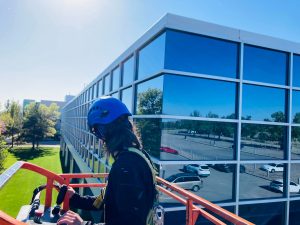WHEN, WHERE, AND HOW TO USE THEM
Lifts can be intimidating. They weigh many tons. They require skill, knowledge, and experience to operate. Some reach dizzying heights. If handled improperly, they can cause great damage and be deadly. They are expensive to rent. In all honesty, they should only be employed as a last resort. That being said, sometimes lifts are the only option. In the hands of a talented operator/window cleaner, they can be very effective.
When should a lift be used? This is why you should always look at a building in person. Don’t just drive around it, don’t google earth it. Give it a thorough going over. Go to the roof, there might be glass up there. There might be a courtyard you can’t see from the street. There might be an open area in the middle of the inside of the building with a glass top. That will require a lift, an electric one, for use indoors. A scissor lift might be a good choice. A free-standing walkway over a street will probably require a stick boom.
 That’s a boom with a telescoping arm. Or an articulating boom. The arm folds like an elbow. Sometimes buildings have large overhangs preventing chair work or stage scaffolding. Many buildings have slanted roofs that you cannot come off of. And some companies don’t have bosun chairs or stage scaffold equipment, but they have an employee who is a talented lift operator. All of these are good reasons for renting a lift.
That’s a boom with a telescoping arm. Or an articulating boom. The arm folds like an elbow. Sometimes buildings have large overhangs preventing chair work or stage scaffolding. Many buildings have slanted roofs that you cannot come off of. And some companies don’t have bosun chairs or stage scaffold equipment, but they have an employee who is a talented lift operator. All of these are good reasons for renting a lift.
Make sure your operator is experienced. And he should be able to clean windows. One could have an operator just to drive the lift and another man to clean the glass, but it will go twice as fast if both are getting the work done and cut your rental time in half. Make sure he is safety trained. At the IWCA Convention, Sunbelt Rentals offers an excellent course. No matter how experienced your employee might be, HAVE HIM TAKE IT!. Some States require certification for operators. A damn good idea.
To rent a lift is very expensive. A rental company will require a credit check. They will charge a fee to cover you if you don’t have the right liability insurance. There will be a pickup and delivery fee. The rental fee itself depends on the type and size of the lift and how long you use it. Get a gas can and refuel it before they pick it up; they charge twice as much per gallon to fill it back up.
 Now that you have had the lift delivered to the building, and are about to clean, don’t just jump in and go. First, go over the manual. Then go over the controls. Then start it up, open the hood, and check the engine and hydraulic lines for leaks. Check the tires. Then check the ground you will be traversing and ensure it is hard, dry, and level. Check with the building supervisor on the location of irrigation systems and water or gas lines. Look out for power lines. Look out for obstacles. Block off areas with foot or automobile traffic. Check the weather forecast, you don’t want to be caught in a thunderstorm or high winds. When you hop into the basket, the first thing you do is hook up your safety harness. I’m sure I left out a lot, so please take the Sunbelt Rental safety course.
Now that you have had the lift delivered to the building, and are about to clean, don’t just jump in and go. First, go over the manual. Then go over the controls. Then start it up, open the hood, and check the engine and hydraulic lines for leaks. Check the tires. Then check the ground you will be traversing and ensure it is hard, dry, and level. Check with the building supervisor on the location of irrigation systems and water or gas lines. Look out for power lines. Look out for obstacles. Block off areas with foot or automobile traffic. Check the weather forecast, you don’t want to be caught in a thunderstorm or high winds. When you hop into the basket, the first thing you do is hook up your safety harness. I’m sure I left out a lot, so please take the Sunbelt Rental safety course.
I love working lifts. It is a carnival ride I get to control. In many ways, it is easier than other window cleaning methods, like ladders. When using a bosun chair, I have to go back up to the roof and re-rig after every drop. Same thing with stage scaffolding. Often, I have to carry weights and beams up to the roof and back down again at the end of the job. Lifts eliminate all of that. Every true high-rise window cleaning company can do this type of work. I can’t tell you if employing this method is right for you. But at least now you have an idea of what is involved. Sooner or later, a building manager will ask every window cleaning company to do a building where you need a man lift. That is when you will have to make your decision.
Matt Johnson
Blue Sky Window Cleaning, INC St. Louis, MO


Recent Comments